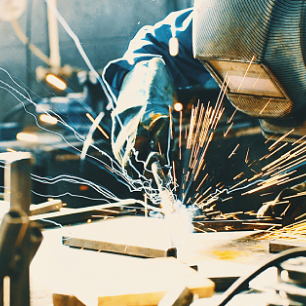Jump to:
Considerations for Your First Welding Robot
You’re thinking of buying your first welding robot. Instead of diving into technical jargon, it is often more helpful to provide a simple, easy-to-read guide focusing on the basics to keep in mind when considering investing in robotic welding.
When adding automation to your manufacturing process, you should be driven by at least one, but ideally both, of these requirements: high-volume welding production and the need for consistent, safe welds.
Process and Robot Selection
Your welding process will help determine what kind of robot you need. Most users start with hard-wire gas metal arc welding. If you’re using flux cored, submerged, or gas tungsten arc welding, don’t worry. Those can be automated, too.
Robots and cobots (collaborative application robots) aren’t cheap. A return on your money won’t be immediate. Focus on consistent quality before expecting financial gains. Then you’ll see improvements in speed and ROI.
Part Consistency
Robots are incredibly precise, often more so than your parts. That’s why consistency matters. Many of you will start with thinner materials (1/4 in. or less), but the shape and repeatability are more important. Simple, flat, laser-cut parts with one bend are ideal. Rolled parts or complex geometries introduce challenges due to variability, like spring-back. Progressively stamped parts can offer excellent repeatability. When starting automation, simplicity and repeatability are your friends.
Fixtures
Good fixtures are essential. If your parts are simple, you might build your own. But for your first robot, it’s wise to outsource your first fixture design to learn what you may or may not be able to do for yourself.
Fixtures don’t need to be high-tech. Avoid the urge to force parts into position, which leads to fixture damage, clamp fatigue, and bad welds. If you’re hammering or prying parts out of a fixture, that’s a sign things are going wrong. If the front of a carousel is bouncing up and down, think of what is happening to the part attached to the other side of the carousel being welded.
Simplicity
Advanced tools — laser trackers, cameras, arc sensors — are available, but they’re expensive and complex. Skip them for your first cell unless you absolutely need them for thick or complex parts. These are all Band-Aids for inconsistent parts and are meant for other uses.
The Right People
When buying a robot and working with an integrator (they don’t need to be from the same company as the manufacturer), give them your best and worst parts and ask for a proof of concept. Make sure the system works before it ships. Better yet, go visit and watch it in person.
When it comes to programming, welders often make better first-time robot programmers than software pros. Welders understand that torch angle, stickout, and travel speed are critical to success, and they are essentially teaching that to an inanimate object.
Programming Tips
Once a program works, avoid constant tweaking. If welds start to fail, do the following:
- Check for torch collisions — rubbing counts.
- Use a straightening fixture for sagging or bending torches.
- Skip the fancy auto-compensators. They tend to hide problems and lead operators down the rabbit hole of touching up the program.
- Establish a routine for checking and fixing torch alignment.
If something goes wrong, you’ll be glad you saved a clean version. Having the original program after confirming good parts is golden. Most issues are caused by the parts, the torch, fixture damage, or even weather changes once you’re running well.
Inspect Welds
Even robots make mistakes. Liners wear out. Tips deform. Aggressive cleaning can misalign the torch. Always inspect your final product.
This article was written by Adam White (Glendale Manufacturing Co.) for the American Welding Society.


